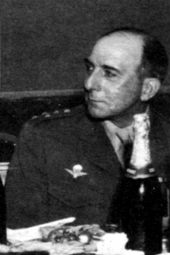Battle of the Sông Đáy
| date | May 30 to June 18, 1951 |
|---|---|
| place | Sông Đáy , Vietnam |
| output | French victory |
| Parties to the conflict | |
|---|---|
| Commander | |
| Troop strength | |
|
3 mobile groups 1 paratrooper regiment tank artillery |
64th Infantry Regiment local infantry regiment |
| losses | |
|
107 killed, |
9,000 killed and wounded |
The Battle of the Sông Đáy resulted from the attempt of the Viet Minh to break into the delta area in Tonking from the southwest along the Sông Đáy river from May to July 1951 . The French forces succeeded in fighting him back in several weeks of fighting with the support of local militias belonging to the Catholic minority. After the battle, the Viet Minh turned to guerrilla warfare again.
prehistory
During the Indochina War , France tried to fight the guerrilla organization of the Viet Minh , which had proclaimed a sovereign state in Vietnam after the Japanese defeat in World War II in 1945 . During the first years of the war, the Viet Minh specialized in the use of guerrilla tactics and the avoidance of conventional combat. With the establishment of the People's Republic of China after the victory of the Communists in the Chinese Civil War , the armed forces of the independence movement were upgraded to a regular army with Chinese support. The military leadership of the Viet Minh around Vo Nguyen Giap therefore planned to break into the delta with conventionally organized large units and, if necessary, to take the urban centers of Tonking. In 1951, the Viet Minh at Vĩnh Yên and Mạo Khê had already failed with great losses.
The Viet Minh planned a new offensive from the southwest towards the delta. The 304th Division should take action against Phu Ly and the 308th Division against Ninh Binh . The 320th Division was to advance in the center towards Phat Diem . The 64th Infantry Regiment infiltrated into French-controlled territory and a local infantry regiment were supposed to lead the attack from the rear of the French front against their supply lines. Shortly before the rice harvest, the Viet Minh leadership expected a gain in controlled territory in the fertile regions of the delta. She also wanted to bring the Catholic population, which had a reputation for collaboration with the French, under their control.
course
The attacks by the Viet Minh began surprisingly for the French on May 29, 1951. The French responded by bringing in three mobile groups , a colonial paratrooper regiment and artillery and armored forces. The French river flotilla Dinassaut was able to interrupt the supply lines of the Viet Minh across the river. The fighting peaked on June 4th. The French were able to regain the initiative on June 6th. A few days later Giap gave the order to withdraw. However, the fighting lasted in places until June 18. According to French data, the Viet Minh lost around 1,000 prisoners and around 9,000 combatants killed. During the battle, the son of the French commander-in-chief in Indochina, Jean de Lattre de Tassigny, fell as a lieutenant in the infantry service.
consequences
Vo Nguyen Giap was heavily criticized by the ideologues of the Trường Chinh party and Ho Chi Minh for the heavy casualties in the conventional battles after the battle on Song Day . The Viet Minh went back to guerrilla warfare after Song Day, as it had been shown that they had failed in a conventional dispute. Giap formulated the change of strategy in a daily order captured by French forces as follows: "Our troops, who have shown their superiority as guerrilla fighters, should no longer seek a massive battle from now on. The general counter-offensive has been canceled. Regional forces are deployed in small troops Small towns and urban networks seep in. The goal of revolutionary warfare remains the population. "
Individual evidence
- ↑ Frederick Logevall: Embers of War - The Fall of an Empire and the Making of America's Vietnam , New York 2013, pp. 268-274
- ↑ a b Bernhard Fall: Street without Joy , 4th edition, Harrisburg, 1994, pp. 43-47
- ↑ Frederick Logevall: Embers of War - The Fall of an Empire and the Making of America's Vietnam , New York 2013, pp. 269-272
- ↑ Frederick Logevall: Embers of War - The Fall of an Empire and the Making of America's Vietnam , New York 2013, pp. 269-272
- ↑ Quoted from Frederick Logevall: Embers of War - The Fall of an Empire and the Making of America's Vietnam , New York 2013, p. 273; Original text in English: "Our troops, who have shown their superiority as guerillas, should, from now on, not seek massive battle. The general counteroffensive is called off. Regional elements will enter by small groups into towns an reinforce the urban networks. The prize of revolutionary warfare remains the population. "
